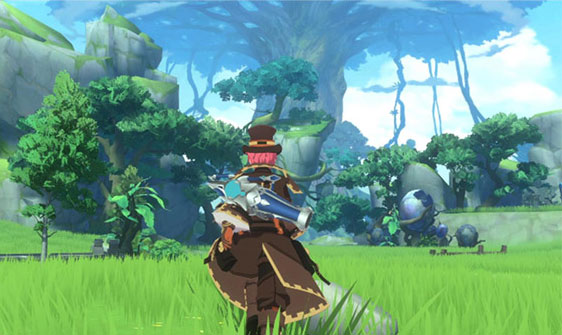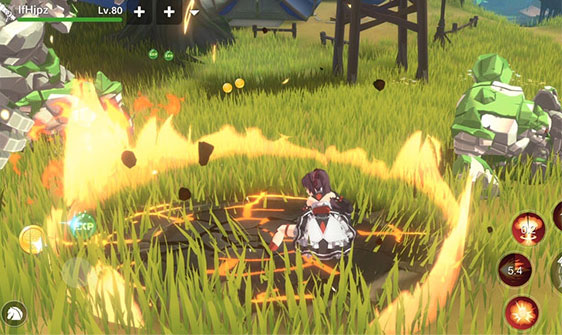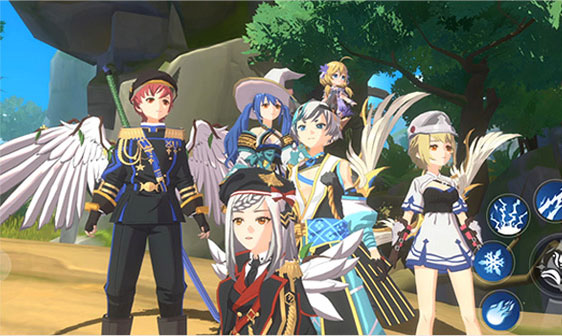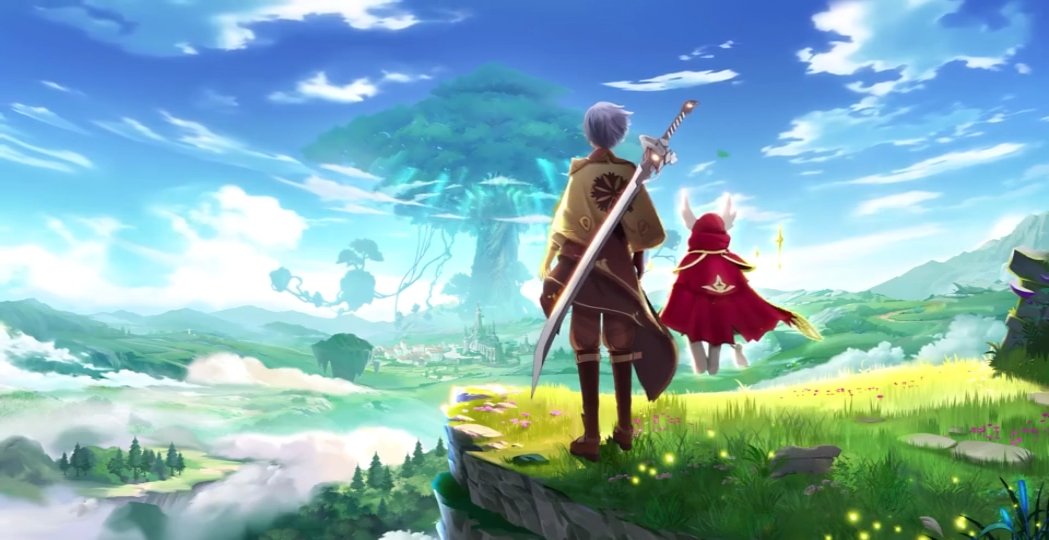The Legend of Neverland is a captivating mobile MMORPG (Massively Multiplayer Online Role-Playing Game) that has caught the attention of gamers around the globe. Developed by GameArk Global, this game offers a visually stunning fantasy world filled with adventure, exploration, and endless possibilities. It draws inspiration from popular MMORPGs, blending classic elements with fresh mechanics to provide a unique and engaging experience. Here’s a deep dive into what makes The Legend of Neverland a standout title in the mobile gaming arena.
A World of Fantasy and Wonder
Set in a mystical land filled with rich lore and vibrant landscapes, The Legend of Neverland invites players into a universe brimming with magic, mysteries, and adventure. The game world is beautifully designed with lush forests, mystical dungeons, serene lakes, and intricate cities, each offering unique environments to explore. Its anime-inspired art style and high-quality graphics create an immersive atmosphere that captivates players from the moment they set foot in the game.
Character Customization and Progression
One of the game’s highlights is its deep character customization system. Players can create their ideal hero by selecting from a variety of classes, including Swordsman, Ranger, Scholar, and Craftsman. Each class has its own unique skills and playstyle, allowing players to choose how they want to experience the world of Neverland.
The game also introduces the concept of “Class Change,” which enables players to switch between classes freely. This flexibility ensures that gameplay remains fresh and dynamic, as players can adapt their strategies to tackle different challenges. As they progress, players can upgrade their characters, unlock powerful abilities, and equip a range of weapons and gear to enhance their performance in battles.
Flower Fairies: Your Loyal Companions
A unique feature in The Legend of Neverland is the Flower Fairy system. These magical companions assist players in combat and exploration. Each Flower Fairy has distinct abilities and attributes that can be upgraded over time. They not only provide aid in battles with their skills but also offer various buffs and enhancements to the player’s character. Collecting and nurturing these Flower Fairies adds another layer of strategy to the game, as players must choose the right companions to complement their playstyle.
Engaging Combat and Exploration
The game’s combat system is action-oriented and skill-based, requiring players to engage in real-time battles against a variety of foes, from wild creatures to formidable bosses. Players must combine their abilities strategically to overcome challenges, making each encounter thrilling and rewarding. The option to switch classes mid-battle adds a tactical depth, allowing for diverse combat scenarios.
Exploration is also a key aspect of The Legend of Neverland. The game world is filled with secrets waiting to be discovered. Players can embark on quests, explore dungeons, and participate in events to earn rewards. The game encourages players to interact with the environment, uncover hidden treasures, and complete puzzles, making the journey through Neverland a captivating adventure.
Social Interaction and Community
As an MMORPG, The Legend of Neverland emphasizes social interaction and community building. Players can team up with friends or other players around the world to take on challenging dungeons and bosses. Guilds are an integral part of the game, offering a platform for players to collaborate, communicate, and compete in guild-exclusive events.
Additionally, the game features various social activities, including fishing, cooking, and gardening. These activities not only provide a break from the intense battles but also allow players to bond with others and develop their characters in a more relaxed setting.

Freemium Model with In-Game Purchases
The Legend of Neverland follows a freemium model, allowing players to download and play the game for free. It offers in-game purchases for items, cosmetics, and other enhancements. While the game can be enjoyed without spending money, these purchases can accelerate progression and offer aesthetic customization options.
Final Thoughts
The Legend of Neverland stands out in the crowded mobile MMORPG market due to its beautiful visuals, engaging gameplay, and rich content. Its blend of character customization, dynamic combat, and social features creates a well-rounded experience that caters to both casual players and MMORPG enthusiasts. Whether you are looking for an epic adventure, strategic combat, or a place to socialize and relax, The Legend of Neverland has something for everyone. Its magical world beckons, offering countless hours of exploration, battles, and camaraderie.
In a realm where imagination knows no bounds, The Legend of Neverland invites you to become a part of its enchanting story. Are you ready to step into the adventure and create your legend
Players’ opinions about The Legend of Neverland vary, reflecting both the game’s strengths and areas for improvement. Here’s a summary of common feedback from the player community:
Positive Feedback
- Stunning Visuals and Art Style: Many players appreciate the game’s anime-inspired art style and high-quality graphics. The vibrant, detailed environments and character designs are frequently praised for their visual appeal.
- Engaging Combat System: Players enjoy the action-oriented, real-time combat system. The ability to switch between classes and use various skills adds depth and excitement to battles, making combat feel dynamic and strategic.
- Character Customization: The extensive character customization options are well-received. Players like the freedom to choose different classes and modify their characters to fit their preferred playstyle.
- Flower Fairy Companions: The Flower Fairy system is a standout feature for many. Players appreciate having magical companions that provide assistance in combat and enhance gameplay with their unique abilities.
- Exploration and Quests: The game’s focus on exploration and questing is often highlighted as a positive aspect. The variety of activities, hidden treasures, and puzzles add to the sense of adventure and discovery.
- Social Features: The multiplayer aspects, such as guilds and cooperative play, are popular among players. Many enjoy the opportunities for social interaction and teamwork that the game provides.
Constructive Criticism
- In-Game Purchases: Some players have expressed concerns about the freemium model and the impact of in-game purchases on gameplay. There are complaints about the balance between free and paid content, with some feeling that certain items or enhancements are too costly.
- Grinding and Progression: A few players find the progression system to be grind-heavy. They mention that advancing through levels and acquiring certain items can be time-consuming and may require significant effort or spending.
- Performance Issues: There have been reports of performance issues, such as lag or crashes, particularly on older devices. These technical problems can detract from the overall experience.
- Limited Endgame Content: Some players feel that the endgame content is lacking or not as engaging as the early stages of the game. They suggest that more diverse and challenging activities could improve long-term player retention.
- Localization and Translation: In some cases, players have noted issues with localization and translation, affecting the clarity of the story and in-game instructions. Better translation quality could enhance the overall experience for non-English speakers.
Overall Sentiment
Overall, The Legend of Neverland receives a mix of praise and constructive feedback. Players are generally enthusiastic about the game’s visual style, combat mechanics, and social features, but they also highlight areas where improvements could be made. The game’s community remains active and engaged, with ongoing discussions about its future updates and potential enhancements
As of my last update, The Legend of Neverland has garnered a substantial user base. The game has seen millions of downloads across various platforms, reflecting its popularity. However, the exact number of active users can fluctuate over time and may vary depending on the source of the data.
For the most current and accurate figures on user numbers or active player counts, checking the game’s official website or recent reports from GameArk Global, the developer, would provide the most up-to-date information.
Review: The Legend of Neverland
The Legend of Neverland stands out in the mobile MMORPG landscape with its enchanting visuals, engaging gameplay, and unique features. Developed by GameArk Global, this game offers a blend of fantasy and adventure that has captivated players worldwide. Here’s an in-depth look at what makes this game worth exploring and where it might need some improvement.
Visuals and Art Style
One of the most striking aspects of The Legend of Neverland is its stunning visual presentation. The game boasts an anime-inspired art style with vibrant colors and detailed environments that draw players into its fantastical world. The character designs, as well as the lush landscapes and mystical settings, contribute to an immersive and visually appealing experience. The high-quality graphics make exploration and combat visually satisfying, enhancing the overall enjoyment of the game.
Gameplay and Combat
The gameplay in The Legend of Neverland is dynamic and engaging, with a focus on real-time combat that requires both strategy and quick reflexes. Players can choose from a variety of classes, including Swordsman, Ranger, Scholar, and Craftsman, each offering a unique playstyle and abilities. The ability to switch between classes adds a layer of depth and flexibility to the gameplay, allowing players to adapt their strategies to different challenges.
Combat is action-oriented and skill-based, which keeps battles exciting and rewarding. The integration of the Flower Fairy system adds another dimension to combat, with magical companions providing support and enhancing gameplay. This system is well-received for its strategic value and the additional layer of customization it brings.
Character Customization
The character customization options in The Legend of Neverland are extensive and appreciated by players. The game allows for deep personalization of characters, from selecting classes to equipping a variety of weapons and gear. The Class Change feature further enhances customization by letting players switch classes freely, which helps keep the gameplay fresh and allows for different tactical approaches.
Exploration and Quests
Exploration is a significant part of the game, with a rich world full of secrets, treasures, and hidden areas waiting to be discovered. The quest system is diverse, offering a range of activities from standard missions to more intricate puzzles and challenges. This variety keeps the gameplay engaging and provides a sense of accomplishment as players uncover new aspects of the world.
Social Features
The game’s social features are well-developed, offering players opportunities to interact, collaborate, and compete. Guilds, cooperative play, and social activities like fishing, cooking, and gardening are integral to the experience. These features foster a sense of community and provide players with ways to connect beyond just combat and quests.
In-Game Purchases and Monetization
While The Legend of Neverland is free to play, it follows a freemium model with in-game purchases for various items and enhancements. This model can be a double-edged sword. On one hand, it allows players to enjoy the game without an upfront cost. On the other hand, some players feel that certain items and enhancements are priced too high, potentially impacting the balance between free and paid content. The game’s monetization approach might be a concern for those who prefer a more balanced free-to-play experience.
Performance and Technical Issues
Performance can vary, with some players reporting lag or crashes, particularly on older devices. These technical issues can detract from the overall experience and may need addressing to ensure a smoother gameplay experience for all users.
Endgame Content and Longevity
The endgame content in The Legend of Neverland is a mixed bag. While the early stages of the game offer a lot of excitement and variety, some players feel that the endgame content lacks depth and challenge. More diverse and engaging activities could enhance the long-term appeal and keep players invested beyond the initial stages.

Localization and Translation
There have been occasional concerns about localization and translation quality. Some players have noted that the game could benefit from improved translations to better convey the story and instructions. This would enhance the overall experience for non-English speakers and improve accessibility.
Final Thoughts
The Legend of Neverland is a visually stunning and enjoyable MMORPG with several standout features, including its beautiful art style, engaging combat, and social elements. Its character customization and exploration aspects are particularly noteworthy. However, it does have areas that could be improved, such as balancing the freemium model, addressing performance issues, and expanding endgame content.
Overall, the game offers a rich and immersive experience that is well worth exploring, especially for fans of fantasy MMORPGs. With some refinement in certain areas, The Legend of Neverland could further solidify its place as a top contender in the mobile gaming market
The Legend of Neverland has both strengths and weaknesses, which can influence whether it’s considered good or bad depending on what you value in a game. Here’s a quick summary:
Strengths:
- Visual Appeal: The game features stunning, anime-inspired graphics and vibrant environments that are visually captivating.
- Engaging Combat: The real-time, action-oriented combat system is dynamic and strategic, offering an exciting gameplay experience.
- Character Customization: Extensive options for customizing characters and switching classes add depth and variety to the gameplay.
- Exploration: The game’s world is rich with secrets, quests, and hidden treasures, making exploration enjoyable.
- Social Features: The inclusion of guilds, cooperative play, and various social activities enhances the community aspect of the game.
Weaknesses:
- Freemium Model: The in-game purchases can be costly, which may affect the balance between free and paid content.
- Performance Issues: Some players experience lag or crashes, particularly on older devices.
- Endgame Content: The game’s endgame content might feel lacking or less engaging compared to the initial stages.
- Localization: Translation and localization issues can affect the clarity of the story and instructions.
Conclusion:
Overall, The Legend of Neverland is generally considered a good game for its impressive visuals, engaging gameplay, and social features. However, the experience can be marred by performance issues, the freemium model, and some localization problems. If you enjoy MMORPGs with a fantasy setting and don’t mind spending on in-game purchases, you might find it quite enjoyable. If these concerns are significant to you, it might be worth considering other options or looking into recent updates to see if the issues have been addressed
The Legend of Neverland was developed by GameArk Global, a company known for creating and publishing mobile games. The founder of GameArk Global is Rong Cheng, who has been involved in various roles within the gaming industry, focusing on mobile and online games.
If you have more specific questions about the game’s development or its team, I can help with that as well!
The impact of user feedback on The Legend of Neverland has been mixed, reflecting both positive and negative aspects of the game. Here’s how user feedback has influenced the game:

Positive Impact:
- Feature Enhancements: Positive feedback often encourages developers to expand or refine game features. For instance, player appreciation for the Flower Fairy system or the Class Change feature may lead to further development and enhancement of these aspects.
- Community Building: Enthusiastic user reviews and social interactions have helped build a strong player community. This positive social environment can enhance player engagement and retention.
- Updates and Improvements: Positive user feedback can drive developers to focus on areas that players enjoy, leading to updates that enhance the overall experience. For example, if players love the graphics and combat mechanics, the developers might prioritize maintaining or improving these elements.
Negative Impact:
- Performance Issues: Negative feedback about performance issues, such as lag or crashes, highlights areas where the game needs technical improvements. This feedback can push developers to address these issues more urgently to improve user satisfaction.
- Freemium Model Concerns: Complaints about the freemium model and in-game purchases can influence the developers to reassess their monetization strategies. This feedback might lead to adjustments in pricing or the introduction of new, more balanced features.
- Localization and Translation: Negative feedback regarding localization and translation can prompt developers to invest in better translation services, improving the game’s accessibility and clarity for non-English speaking players.
- Endgame Content: If players express dissatisfaction with endgame content, developers might be encouraged to introduce more diverse and challenging activities to keep players engaged long-term.
Overall Impact:
The impact of user feedback is generally constructive. While negative feedback can highlight issues that need addressing, it often leads to improvements and updates that enhance the game. Positive feedback reinforces what works well, encouraging developers to maintain and expand on successful features. In summary, user feedback—both positive and negative—plays a crucial role in shaping the game’s development and ensuring that it continues to evolve to meet players’ expectations
